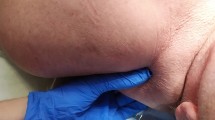Abstract
The spinal accessory nerve (SAN) is a vital structure encountered in many surgeries of the head and neck. The anatomy of the SAN is complex, and identification intraoperatively is key in preventing injury. Compromise of the SAN leads to an array of findings known as postoperative shoulder syndrome, which has a significant impact on patients’ quality of life and contributes to a significant amount of malpractice litigations. Surgeries where the SAN is most at risk include neck dissection, surgery of the posterior triangle such as lymph node biopsies, and lateral skull base surgery. While the frequency of postoperative shoulder syndrome has been mitigated by the trend toward SAN-sparing surgeries in head and neck cancer, it remains a worrisome complication. Intraoperative nerve monitoring is widely used in various head and neck surgeries and has more recently been applied to the SAN. Literature to support the use is variable and relatively limited.
Access this chapter
Tax calculation will be finalised at checkout
Purchases are for personal use only
Similar content being viewed by others
References
Overland J, Hodge JC, Breik O, Krishnan S. Surgical anatomy of the spinal accessory nerve: review of the literature and case report of a rare anatomical variant. J Laryngol Otol. 2016;130(10):969.
Wilkinson JL. Neuroanatomy for medical students [Internet]. Butterworth-Heinemann; 1992. Available from: https://books.google.com/books?id=wbp8yQEACAAJ.
Rea P. Chapter 11 – Spinal accessory nerve. In: Rea PBT-CA of the CN, editor. San Diego: Academic Press; 2014. p. 117–25. Available from: http://www.sciencedirect.com/science/article/pii/B9780128008980000117.
Hinsley ML, Hartig GK. Anatomic relationship between the spinal accessory nerve and internal jugular vein in the upper neck. Otolaryngol Neck Surg. 2010;143(2):239–41.
Standring S. Gray’s anatomy E-book: the anatomical basis of clinical practice. Elsevier Health Sciences; 2016.
Weisberger EC. The efferent supply of the trapezius muscle: a neuroanatomic basis for the preservation of shoulder function during neck dissection. Laryngoscope. 1987;97(4):435–45.
Robbins KT, Clayman G, Levine PA, Medina J, Sessions R, Shaha A, et al. Neck dissection classification update: revisions proposed by the American Head and Neck Society and the American Academy of Otolaryngology–Head and Neck Surgery. Arch Otolaryngol Neck Surg [Internet]. 2002;128(7):751–8. Available from: https://doi.org/10.1001/archotol.128.7.751.
Nason RW, Abdulrauf BM, Stranc MF. The anatomy of the accessory nerve and cervical lymph node biopsy. Am J Surg. 2000;180(3):241–3.
Ewing MR, Martin H. Disability following “radical neck dissection”. An assessment based on the postoperative evaluation of 100 patients. Cancer. 1952;5(5):873–83.
Goldstein DP, Ringash J, Bissada E, Jaquet Y, Irish J, Chepeha D, et al. Scoping review of the literature on shoulder impairments and disability after neck dissection. Head Neck. 2014;36(2):299–308.
Johnson JT, Rosen CA. Bailey’s head & neck surgery otolaryngology. Lippincott; 2014.
Terrell JE, Welsh DE, Bradford CR, Chepeha DB, Esclamado RM, Hogikyan ND, et al. Pain, quality of life, and spinal accessory nerve status after neck dissection. Laryngoscope [Internet]. 2000;110(4):620–6. Available from: https://doi.org/10.1097/00005537-200004000-00016.
Valtonen EJ, Lilius HG. Late sequelae of iatrogenic spinal accessory nerve injury. Acta Chir Scand. 1974;140(6):453–5.
Gane EM, Michaleff ZA, Cottrell MA, McPhail SM, Hatton AL, Panizza BJ, et al. Prevalence, incidence, and risk factors for shoulder and neck dysfunction after neck dissection: a systematic review. Eur J Surg Oncol [Internet]. 2017;43(7):1199–218. Available from: http://www.sciencedirect.com/science/article/pii/S0748798316309660.
Morris LGT, Ziff DJS, DeLacure MD. Malpractice litigation after surgical injury of the spinal accessory nerve: an evidence-based analysis. Arch Otolaryngol Neck Surg [Internet]. 2008;134(1):102–7. Available from: https://doi.org/10.1001/archotol.134.1.102.
Ware Jr JE. SF-36 health survey. 1999;
Ware JE, Keller SD, Kosinski M. SF-12: how to score the SF-12 physical and mental health summary scales. Health Institute, New England Medical Center; 1995.
Terrell JE, Nanavati KA, Esclamado RM, Bishop JK, Bradford CR, Wolf GT. Head and neck cancer—specific quality of life: instrument validation. Arch Otolaryngol Neck Surg. 1997;123(10):1125–32.
Constant CR, Murley AG. A clinical method of functional assessment of the shoulder. Clin Orthop Relat Res. 1987;214:160–4.
McGarvey AC, Hoffman GR, Osmotherly PG, Chiarelli PE. Intra-operative monitoring of the spinal accessory nerve: a systematic review. J Laryngol Otol. 2014;128(9):746.
Chu W, Strawitz JG. Results in suprahyoid, modified radical, and standard radical neck dissections for metastatic squamous cell carcinoma: recurrence and survival. Am J Surg [Internet]. 1978;136(4):512–5. Available from: http://www.sciencedirect.com/science/article/pii/0002961078902726.
Jesse RH, Ballantyne AJ, Larson D. Radical or modified neck dissection: a therapeutic dilemma. Am J Surg [Internet]. 1978;136(4):516–9. Available from: http://www.sciencedirect.com/science/article/pii/0002961078902738.
Muzaffar K. Therapeutic selective neck dissection: a 25-year review. Laryngoscope [Internet]. 2003;113(9):1460–5. Available from: https://doi.org/10.1097/00005537-200309000-00005.
Lloyd S. Accessory nerve: anatomy and surgical identification. J Laryngol Otol [Internet]. 2007;121(12):1118–25. Available from: http://libproxy.temple.edu/login?url=https://search.proquest.com/docview/274820196?accountid=14270.
Griessenauer CJ, McGrew B, Matusz P, De Caro R, Loukas M, Tubbs RS. Surgical approaches to the Jugular Foramen: a comprehensive review. J Neurol Surg B Skull Base [Internet]. 2015/11/16. 2016;77(3):260–4. Available from: https://pubmed.ncbi.nlm.nih.gov/27175322.
Stankovic P, Wittlinger J, Georgiew R, Dominas N, Hoch S, Wilhelm T. Continuous intraoperative neuromonitoring (cIONM) in head and neck surgery—a review. HNO. 2020:1–7.
Midwinter K, Willatt D. Accessory nerve monitoring and stimulation during neck surgery. J Laryngol Otol. 2002;116(4):272–4.
Lee C-H, Huang N-C, Chen H-C, Chen M-K. Minimizing shoulder syndrome with intra-operative spinal accessory nerve monitoring for neck dissection. Acta Otorhinolaryngol Ital. 2013;33(2):93.
Lanišnik B, Žitnik L, Levart P, Žargi M, Rodi Z. The impact on post-operative shoulder function of intraoperative nerve monitoring of cranial nerve XI during modified radical neck dissection. Eur Arch Oto Rhino Laryngol. 2016;273(12):4445–51.
Birinci Y, Genc A, Ecevit MC, Erdag TK, Guneri EA, Oztura I, et al. Spinal accessory nerve monitoring and clinical outcome results of nerve-sparing neck dissections. Otolaryngol Neck Surg. 2014;151(2):253–9.
Witt RL, Rejto L. Spinal accessory nerve monitoring in selective and modified neck dissection. Laryngoscope. 2007;117(5):776–80.
Author information
Authors and Affiliations
Corresponding author
Editor information
Editors and Affiliations
Rights and permissions
Copyright information
© 2022 The Author(s), under exclusive license to Springer Nature Switzerland AG
About this chapter
Cite this chapter
Molin, N., Liu, J.C. (2022). Spinal Accessory Nerve Monitoring in Head and Neck Surgery. In: Scharpf, J., Randolph, G.W. (eds) Intraoperative Cranial Nerve Monitoring in Otolaryngology-Head and Neck Surgery. Springer, Cham. https://doi.org/10.1007/978-3-030-84916-0_17
Download citation
DOI: https://doi.org/10.1007/978-3-030-84916-0_17
Published:
Publisher Name: Springer, Cham
Print ISBN: 978-3-030-84915-3
Online ISBN: 978-3-030-84916-0
eBook Packages: MedicineMedicine (R0)




